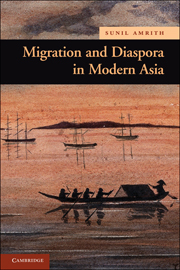Book contents
- Frontmatter
- Contents
- List of Plates, Tables, and Maps
- Acknowledgements
- Select Timeline
- Glossary
- Maps
- Introduction
- 1 Asia's Great Migrations, 1850–1930
- 2 The Making of Asian Diasporas, 1850–1930
- 3 War, Revolution, and Refugees, 1930–1950
- 4 Migration, Development, and the Asian City, 1950–1970
- 5 Asian Migrants in the Age of Globalization, 1970–2010
- Conclusion
- Guide to Further Reading
- Index
4 - Migration, Development, and the Asian City, 1950–1970
Published online by Cambridge University Press: 05 June 2012
- Frontmatter
- Contents
- List of Plates, Tables, and Maps
- Acknowledgements
- Select Timeline
- Glossary
- Maps
- Introduction
- 1 Asia's Great Migrations, 1850–1930
- 2 The Making of Asian Diasporas, 1850–1930
- 3 War, Revolution, and Refugees, 1930–1950
- 4 Migration, Development, and the Asian City, 1950–1970
- 5 Asian Migrants in the Age of Globalization, 1970–2010
- Conclusion
- Guide to Further Reading
- Index
Summary
It was night when the tailors arrived in the city. Groaning and clanking, the train pulled into the station while an announcement blared like gibberish from the loudspeakers. Passengers poured into the sea of waiting friends and families. There were shrieks of recognition, tears of happiness. The platform became a roiling swirl of humanity. Coolies conducted aggressive forays to offer their muscular services.
Ishvar and Omprakash stood frozen on the edge of the commotion. The sense of adventure that had flowered reluctantly during the journey wilted. “Hai Ram,” said Ishvar, wishing for a familiar face. “What a huge crowd.”
Rohinton Mistry, A Fine BalanceIn the 1930s, large empires – British, Dutch, French, American, and Japanese – controlled Asia. By 1950, Asia was divided into nation-states. Between 1945 and 1949, India, Pakistan, Burma, Sri Lanka, Indonesia, and the Philippines became independent. The Communist revolution in China created two states – the People's Republic of China and a de facto nationalist state in Taiwan – as did the partition of Korea into North and South Korea: both divisions last to this day. The breakup of empires and the drawing of new borders produced countless refugees (Chapter 3). It also produced a patchwork of minority populations within each new set of borders. Each new state faced the historical legacy of the mass immigration of an earlier era (Chapter 1), with the presence of large populations of what imperial administrators had once called ‘foreign Asians’: primarily people of Indian and Chinese origin.
- Type
- Chapter
- Information
- Migration and Diaspora in Modern Asia , pp. 117 - 150Publisher: Cambridge University PressPrint publication year: 2011



